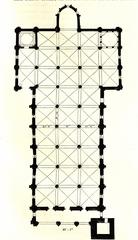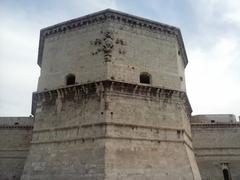Visiting Terme di Traiano in Civitavecchia: Hours, Tickets, and Tips
Date: 31/07/2024
Introduction
Discover the grandeur of ancient Rome with a visit to the Terme di Traiano, one of the most significant historical sites in the city. Located in Civitavecchia, Italy, the Terme di Traiano, also known as the Taurine Baths, offer a fascinating glimpse into the luxurious lifestyle of ancient Romans. This comprehensive guide will delve into the rich history, architectural marvels, and practical visitor information to help you plan an unforgettable trip. Whether you’re a history enthusiast or a casual traveler, exploring the Terme di Traiano is a journey back in time to the heyday of the Roman Empire. Designed by the acclaimed architect Apollodorus of Damascus, this complex was constructed between 104 and 109 AD, following the devastating fire that destroyed Nero’s Golden House (Wikipedia). The baths were not only a marvel of engineering and architecture but also a symbol of the Roman Empire’s prosperity and the emperor’s benevolence. Over the centuries, they have served as a public amenity, a social hub, and a cultural landmark, adorned with statues and artworks that enhanced their aesthetic value (Wikipedia).
Table of Contents
- Introduction
- Historical Background of Terme di Traiano
- Visitor Information: Terme di Traiano Tickets, Hours, and Tips
- Future Prospects and Restoration Efforts
- FAQ
- Conclusion
Historical Background of Terme di Traiano
Construction and Architectural Design
The Terme di Traiano, or Trajan’s Baths, were constructed between 104 and 109 AD, following the devastating fire that destroyed the Domus Aurea, Nero’s Golden House. The project was commissioned by Emperor Trajan and designed by the renowned architect Apollodorus of Damascus, who was also responsible for other significant constructions of the era, including the Forum of Trajan and the Markets of Trajan.
The baths were built on a vast area of over six hectares, previously occupied by various structures, including the Esquiline pavilion of the Domus Aurea and the Baths of Titus. These earlier buildings were oriented along a North-South axis. However, Apollodorus reoriented the new complex 36 degrees off this axis to maximize solar exposure, ensuring optimal heating for the calidarium (hot bath) from noon to sunset (source).
Layout and Features
The Terme di Traiano were the first of Rome’s ‘great baths,’ setting a precedent for subsequent imperial bath complexes. The layout consisted of two main parts: the enclosure buildings and the central body. The central body housed the primary bathing facilities, including the calidarium, tepidarium (warm bath), frigidarium (cold bath), and natatio (swimming pool). The enclosure buildings contained various ancillary facilities, such as gymnasiums, libraries, and gardens.
The plan of the baths has been reconstructed through fragments of the Forma Urbis Severiana, drawings from the 16th and 17th centuries, and the numerous ruins still visible on the Oppian Hill (source). The complex’s design reflects the ‘Grande Tipo Imperiale’ (Great Imperial Type), characterized by its grand scale and sophisticated engineering.
Historical Significance
The Terme di Traiano were not only a marvel of engineering and architecture but also a symbol of the Roman Empire’s prosperity and the emperor’s benevolence. The baths were a public amenity, accessible to all citizens, and served as a social and cultural hub. They were adorned with statues and artworks, enhancing their aesthetic and cultural value.
Ancient literary sources indicate that the baths remained in use until the 4th or 5th century AD. During this period, they were embellished with statues by the prefect of the city, Felix Campanianus (source). The complex likely ceased functioning as a bathhouse after the Goth king Vitiges cut the aqueducts in 537 AD to force Rome’s surrender. However, recent archaeological findings suggest that the baths may have fallen out of use earlier, in the 5th century, as evidenced by the discovery of a necropolis within the complex (source).
Preservation and Rediscovery
During the Middle Ages, the Oppian Hill, where the baths were located, was relegated to the outskirts of the inhabited area and used for vineyards and gardens. This agricultural use helped preserve much of the bath complex from being overbuilt by later constructions (source).
In modern times, various excavations have uncovered significant artifacts from the site, including mosaics and frescoes. Notable discoveries include the ‘Painted City’ fresco, the ‘Harvest Mosaic,’ and a rare wall mosaic depicting Apollo and the Muses, which was found during recent excavations by the Rome Capital Cultural Heritage Superintendency (source).
Archaeological Findings
The archaeological excavations at the Terme di Traiano have revealed a wealth of artifacts that provide insight into the complex’s history and use. Among the most significant finds are the mosaics and frescoes from the underground buildings predating the baths. These include the ‘Painted City’ fresco, which depicts an urban landscape, and the ‘Harvest Mosaic,’ illustrating scenes of grape harvesting (source).
One of the most prestigious discoveries is the wall mosaic of Apollo and the Muses, which measures approximately 16 meters in length. This mosaic is a rare example of parietal (wall) mosaic art and highlights the high level of craftsmanship and artistic achievement during the period (source).
Decline and Legacy
The decline of the Terme di Traiano began with the disruption of the water supply in the 6th century. The complex’s abandonment was further accelerated by the political and economic turmoil of the time. By the 7th century, the area had been repurposed for burials, as indicated by the necropolis found in the northeastern exedra (source).
Despite their decline, the Terme di Traiano left a lasting legacy. They set a standard for subsequent Roman baths, influencing the design and construction of later complexes such as the Baths of Caracalla and the Baths of Diocletian. The architectural innovations and grandeur of the Terme di Traiano continue to be studied and admired by historians and archaeologists today.
Visitor Information: Terme di Traiano Tickets, Hours, and Tips
Accessibility and Location
The Terme di Traiano is located about 4 km east of Civitavecchia, making it easily accessible for visitors. The site is part of an archaeological park, providing a well-preserved glimpse into ancient Roman life. Visitors can explore both the Republican and Imperial bath areas, including the changing rooms and hot and cold pools.
Visiting Hours and Tickets
- Visiting Hours: The Terme di Traiano is open to the public from 9:00 AM to 6:00 PM daily. The best time to visit is during the early morning or late afternoon to avoid the midday heat.
- Tickets: Tickets can be purchased on-site or online. The entrance fee is €10 for adults and €5 for children and seniors. Guided tours are available for an additional fee.
Notable Features
One of the most striking features of the Terme di Traiano is the mosaic floor in the atrium of the Republican baths, depicting stars and diamonds. The large exedra and the domed round bath, later converted into a laconicum, are also significant highlights. The site offers a unique opportunity to see the intricate mosaics and architectural details that have survived for centuries.
Tips for Visitors
- Guided Tours: Consider taking a guided tour to gain deeper insights into the history and significance of the site.
- Photography: Photography is allowed, but be respectful of the site and other visitors.
- Facilities: There are limited facilities on-site, so plan accordingly. Bring water and wear comfortable walking shoes.
Future Prospects and Restoration Efforts
The Terme di Traiano holds significant potential for further archaeological discoveries. The limits of the site have yet to be fully explored, which may clarify its history and provide new insights into ancient Roman engineering and architecture. The proposal to nominate the site as a UNESCO World Heritage site underscores its cultural and historical importance, potentially attracting more visitors and funding for further restoration and preservation efforts (Wikipedia).
FAQ
-
What are the visiting hours of Terme di Traiano? The site is open from 9:00 AM to 6:00 PM daily.
-
How much do tickets cost for Terme di Traiano? Tickets are €10 for adults and €5 for children and seniors.
-
Are guided tours available at Terme di Traiano? Yes, guided tours are available for an additional fee.
-
What are the best times to visit Terme di Traiano? The best times to visit are in the early morning or late afternoon to avoid the midday heat.
Conclusion
The Terme di Traiano is a remarkable testament to ancient Roman engineering, culture, and social life. Its historical significance, architectural grandeur, and the ongoing efforts to preserve and restore the site make it a must-visit destination for anyone interested in Roman history and archaeology. Whether you’re a history buff, an archaeology enthusiast, or simply looking for a unique travel experience, the Terme di Traiano offers a fascinating journey back in time.
Stay up to date with the latest information on Terme di Traiano by downloading the Audiala mobile app, checking out related posts, or following us on social media for more updates.
References
- Terme di Traiano (n.d.). Wikipedia. Retrieved from https://it.wikipedia.org/wiki/Terme_di_Traiano
- Terme Taurine (n.d.). Wikipedia. Retrieved from https://en.wikipedia.org/wiki/Terme_Taurine
- Taurine Baths Civitavecchia (n.d.). Port Mobility. Retrieved from https://civitavecchia.portmobility.it/en/taurine-baths-civitavecchia
- Ultimate Guide to One Day in Civitavecchia, Italy (n.d.). Be Lavie. Retrieved from https://be-lavie.com/ultimate-guide-to-one-day-in-civitavecchia-italy/





